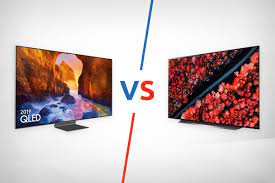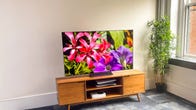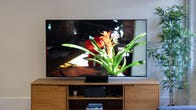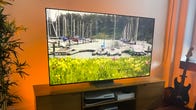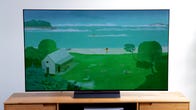QLED vs. OLED: What’s the Difference and Which TV Is Better?
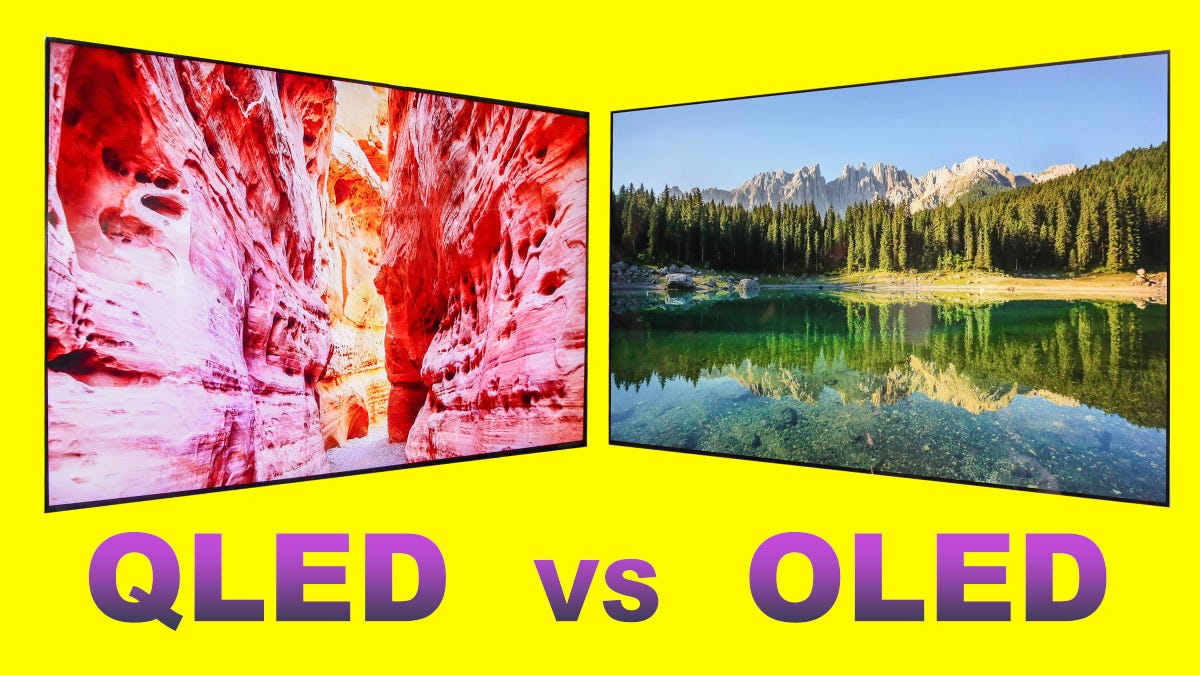
Image by Sarah Tew/CNET
What’s happening
Two fundamentally different TV technologies, QLED and OLED, have similar names.
Why it matters
If you’re buying a new TV, you’ll want to know the differences between each one.
What it means for you
In our side-by-side reviews, OLED beats QLED, but you can save some money with QLED.
Now that the 2022 holiday shopping season is here, you might be thinking of getting a new TV. Now is definitely the best time of year to take advantage of TV deals, but figuring out what TV to buy is still confusing. The best TVs advertise an alphanumeric soup of extras like HDR, 120Hz and HDMI 2.1 and many TVs include all of those features and many more, making it tough to tell the difference.
Unlike the rest of those TV tech terms, QLED and OLED are actually fundamentally different, even though they’re only one letter apart. And in our side-by-side comparison reviews, one is better than the other.
For the last few years, Samsung has been branding its TVs “QLED.” Its 2022 QLED lineup includes Neo QLED models in 4K and 8K resolution, The Frame art TV, Serif and the Sero rotating TV all bearing the ubiquitous Q. And Samsung isn’t the only one. TCL also makes QLED TVs, including the excellent 6-Series, and Amazon even has a Fire TV Omni QLED television of its own.
On the other side of the fence are OLED TVs. In the last few years LG has dominated the OLED market and its 2022 OLED TV lineup is more extensive than ever, but Sony and Vizio also sell OLED TVs in the US. And adding to the confusion, Samsung has an OLED TV of its own in 2022, meaning it sells both OLED and QLED TVs this year.
So what’s the difference between OLED and QLED? We’ll start with picture quality. In our side-by-side comparison reviews, OLED beats QLED every time. We compared last year’s Editors’ Choice OLED TV — the LG C1 series — against the best 2022 Samsung 4K QLED TV, the Samsung QN90B series. The Samsung QLED came closer than ever to the LG OLED, but the LG still won. We also pitted a TCL 8K QLED TV against the 2022 LG OLED C2. Again, the OLED TV won.
We expect OLED TVs to continue to outperform QLED TVs in our tests. Here’s why.
QLED vs. OLED: Quick summary of the TV technologies
Let’s start with a quick breakdown.
- OLED stands for “organic light-emitting diode.”
- QLED (according to Samsung) stands for “quantum dot LED TV.”
- OLED is a fundamentally different technology from LCD, the major type of TV.
- QLED is a variation of LED LCD, adding a quantum dot film to the LCD “sandwich.”
- OLED is “emissive,” meaning the pixels emit their own light.
- QLED, like LCD, is “transmissive” in its current form and relies on an LED backlight.
A QLED TV is just an LCD TV with quantum dots
The main takeaway is that QLED is closer to regular old LCD than it is to OLED, which I (and most other experts) consider a distinctly different class of television, much like plasma before it.
Quantum dots are microscopic molecules that, when hit by light, emit their own differently colored light. In QLED TVs, the dots are contained in a film, and the light that hits them is provided by an LED backlight. That light then travels through a few other layers inside the TV, including a liquid crystal (LCD) layer, to create the picture. The light from the LED source is transmitted through the layers to the screen’s surface, which is why we say it’s “transmissive.”
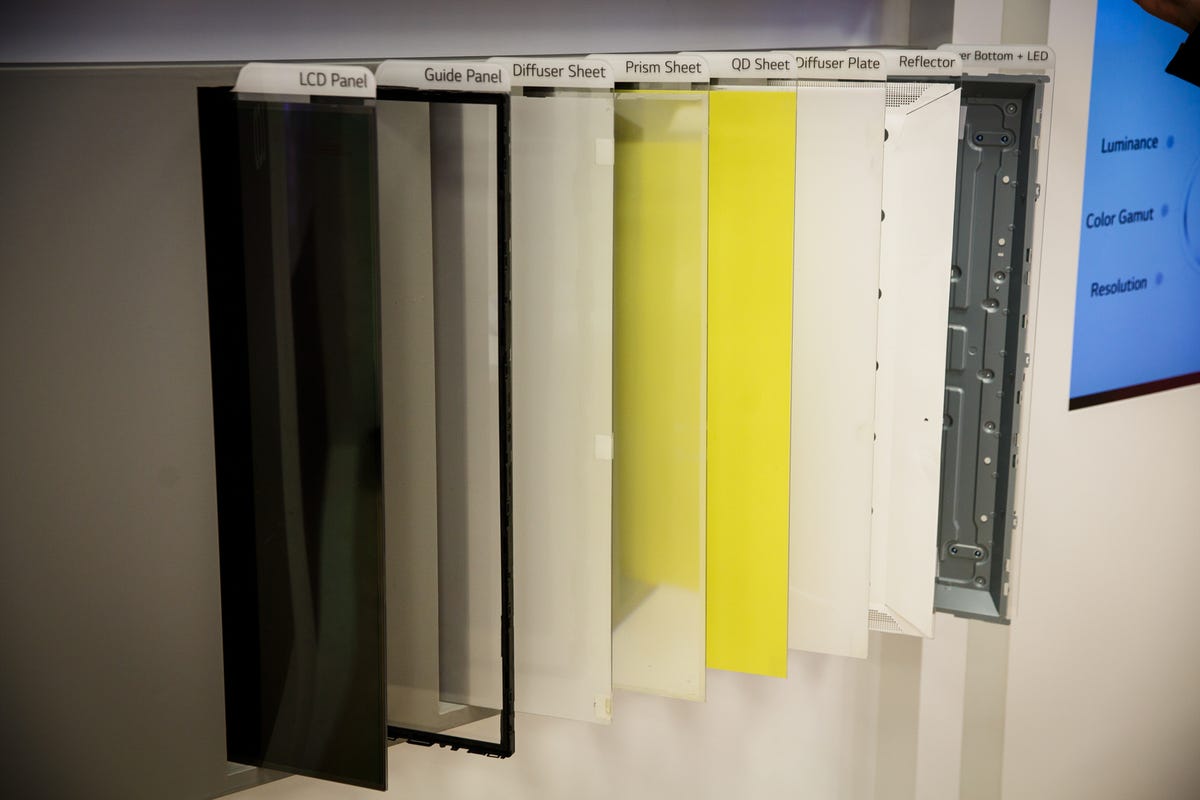
Josh Miller/CNET
Samsung has been using quantum dots to augment its LCD TVs since 2015 and debuted the QLED TV branding in 2017. Samsung says those quantum dots have evolved over time — that color and light output have improved, for example. In my experience, however, improvements caused by better quantum dots are much less evident than those caused by other image quality factors (see below).
Other TV makers also use quantum dots in LCD TVs, including Vizio and Hisense, but don’t call those sets QLED TVs.
An OLED TV is not an LCD TV at all
LCD is the dominant technology in flat-panel TVs and has been for a long time. It’s cheaper than OLED, especially in larger sizes, and numerous panel-makers can manufacture it.
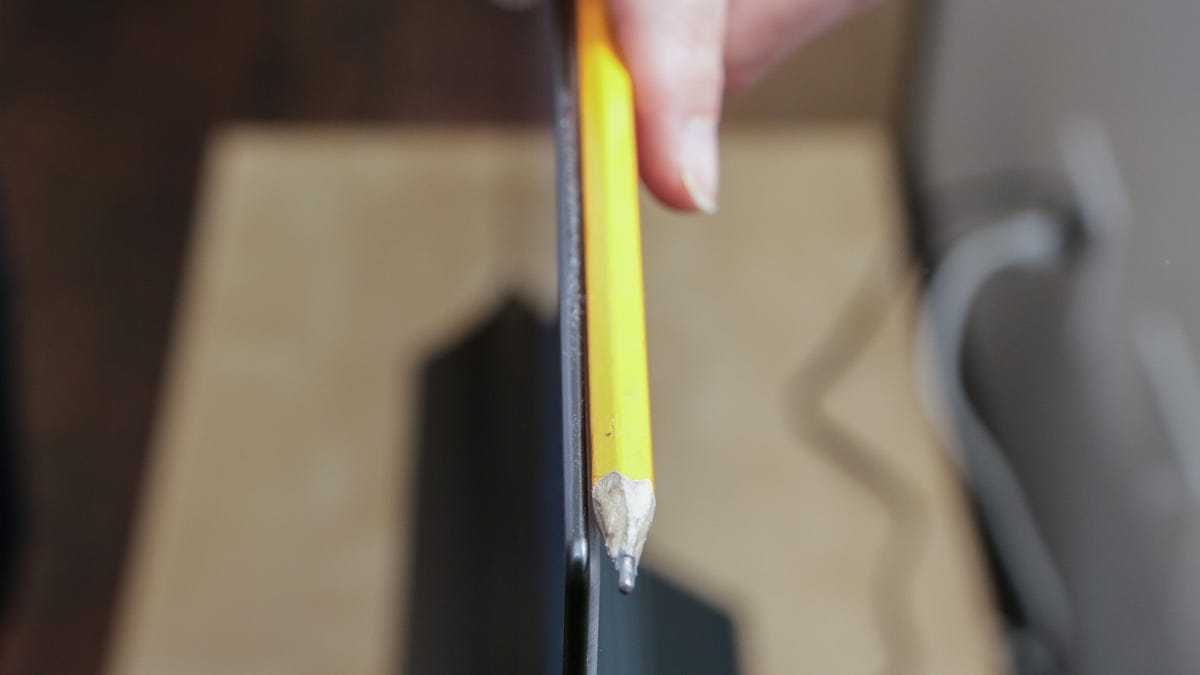
Sarah Tew/CNET
OLED is different because it doesn’t use an LED backlight to produce light. Instead, light is produced by millions of individual OLED subpixels. The pixels themselves — tiny dots that compose the image — emit light, which is why it’s called an “emissive” display technology. That difference leads to all kinds of picture quality effects, some of which favor LCD (and QLED), but most of which favor OLED.
Aside from the US brands mentioned above, Panasonic, Philips, Grundig and others sell OLED TVs in Europe. All OLED TVs worldwide, including those in the US, use panels manufactured by LG Display.
That’s about to change, however. Samsung and Sony will soon debut the first OLED TVs made by Samsung Display. They promise improved color and brightness compared to current OLED TVs because they use quantum dots — just like QLED TVs. Called QD-OLED or QD Display, they’re sure to be quite expensive at first, even more than standard OLED TVs, but prices will come down eventually.
QLED vs. OLED image quality
Based on my reviews, here are some general comparisons I’ve made between the two.
QLED TV picture quality varies more than OLED
Meanwhile, every OLED TV I’ve reviewed has very similar image quality — all have earned a 10/10 in picture quality in my tests. There’s some variation among different OLED TVs, for example the LG A2 with its 60Hz panel compared to 120Hz on other OLED TVs, but they’re not nearly as significant as the differences between various QLED TV series. Samsung and TCL each have multiple QLED series and the most expensive ones perform a lot better than the cheaper ones. That’s mainly because the biggest improvements in the picture quality of QLED sets don’t have much to do with quantum dots. Instead they’re the result of mini-LED backlights, better full-array local dimming, bright highlights and better viewing angles, which help them outperform QLED (and non-QLED) TVs that lack those extras.
OLED has better contrast and black level
One of the most important image quality factors is black level, and their emissive nature means OLED TVs can turn unused pixels off completely, for literally infinite contrast. QLED/LCD TVs, even the best ones with the most effective full-array local dimming, let some light through, leading to more washed-out, grayer black levels and blooming around bright sections.
QLED is brighter
The brightest QLED and LCD TVs can get brighter than any OLED model, which is a particular advantage in bright rooms and with HDR content. In my tests, however, OLED TVs can still get plenty bright for most rooms, and their superior contrast still allows them to deliver a better overall HDR image than any QLED/LCD TV I’ve tested.
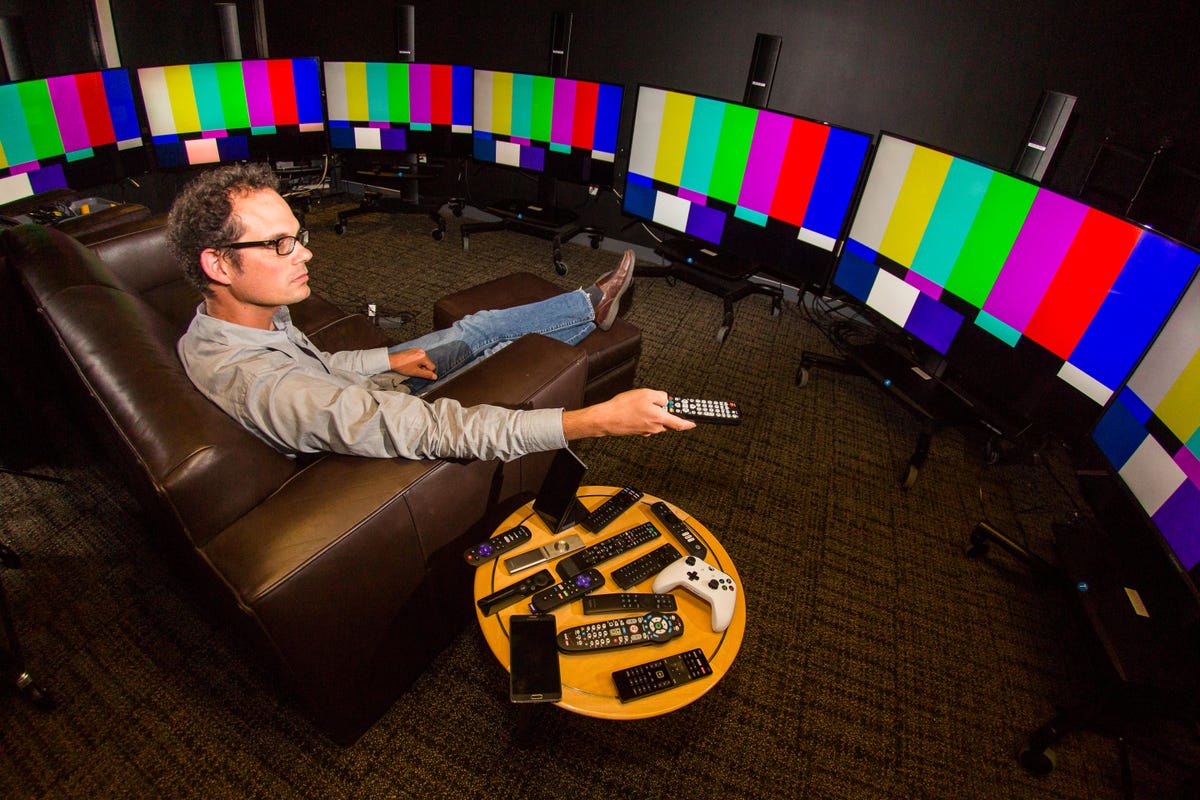
OLED has better uniformity and viewing angles
With LCD-based displays, different areas of the screen can appear brighter than others all the time, and backlight structure can also be seen in some content. Even the best LCDs also fade, lose contrast and become discolored when seen from seats other than the sweet spot directly in front of the screen. OLED TVs have almost perfectly uniform screens and maintain fidelity from all but the most extreme angles.
Resolution, color, video processing and other image quality factors are basically the same
Most QLED and OLED have the same resolution and 4K, and both can achieve 8K resolution too. Neither technology has major inherent advantages in color or video processing, although QD-OLED could deliver improved color. Check out OLED vs. LCD for more details.
QLED can get bigger and smaller (and cheaper)
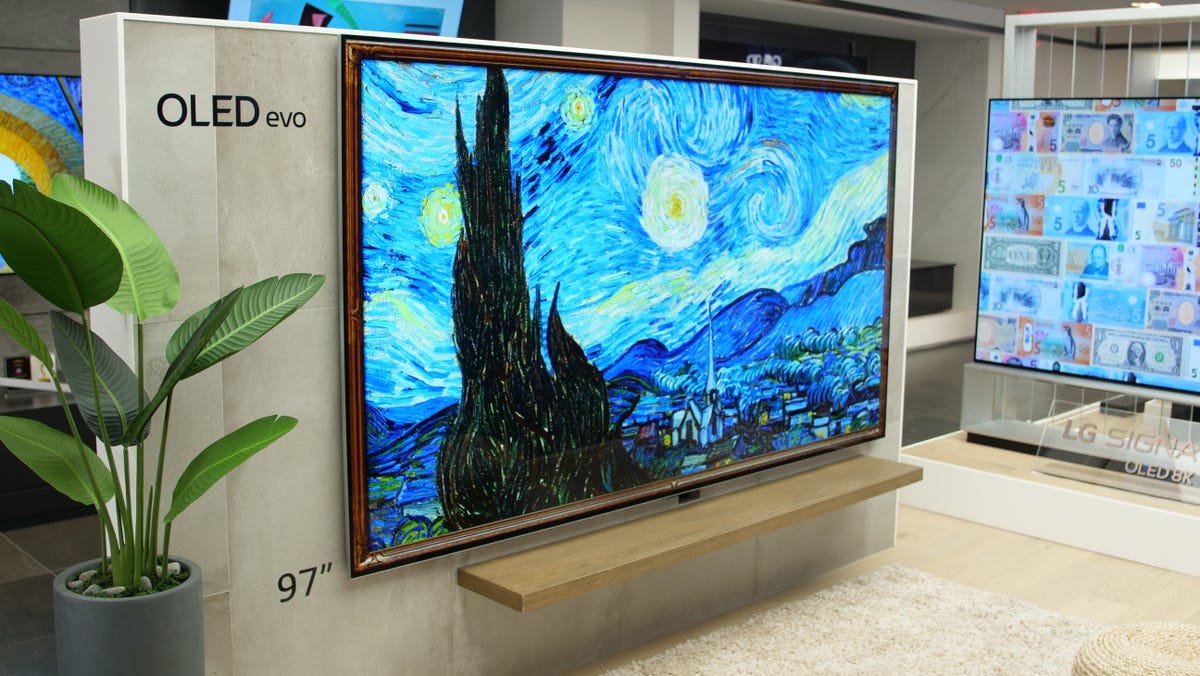
Richard Peterson/CNET
There are six sizes of OLED TV on the market today and two more sizes, 42-inch and 97-inch, are new for 2022.
OLED TV sizes
- 42-inch
- 48-inch
- 55-inch
- 65-inch
- 77-inch
- 83-inch
- 88-inch
- 97-inch
Meanwhile, as QLED TVs are LCDs they are able to be made in a greater range of sizes. Non-QLED LCD TVs can get even smaller.
QLED TV sizes
- 32-inch
- 43-inch
- 50-inch
- 55-inch
- 58-inch
- 65-inch
- 75-inch
- 82-inch
- 85-inch
- 98-inch
One big advantage, so to speak, that QLED and LCD have over OLED is the cost of mainstream sizes over 65 inches. Large televisions are the fastest-growing segment of the market and show no signs of slowing down. 77-inch OLED TVs cost $2,500 and up, significantly more than most 75-inch QLED TVs, and in larger sizes the difference is even more drastic.
What about OLED burn-in?
Burn-in happens when a persistent part of the image — navigation buttons on a phone or a channel logo, news ticker or a scoreboard on a TV, for example — remains as a ghostly background no matter what else appears on screen. All OLED screens can burn-in, and from everything I know, they’re more susceptible than LCD displays, including QLED.
All things considered, however, burn-in shouldn’t be a problem for most people. From all of the evidence we’ve seen, burn-in is typically caused by leaving a single, static image element, like a channel logo, which appears on the screen for a long time, repeatedly. That’s an issue if you keep Fox News, ESPN or MSNBC on for multiple hours every day and don’t watch enough other programming, for example. But as long as you vary what’s displayed, chances are you’ll never experience burn-in.
Check out our guide on OLED screen burn-in for more.
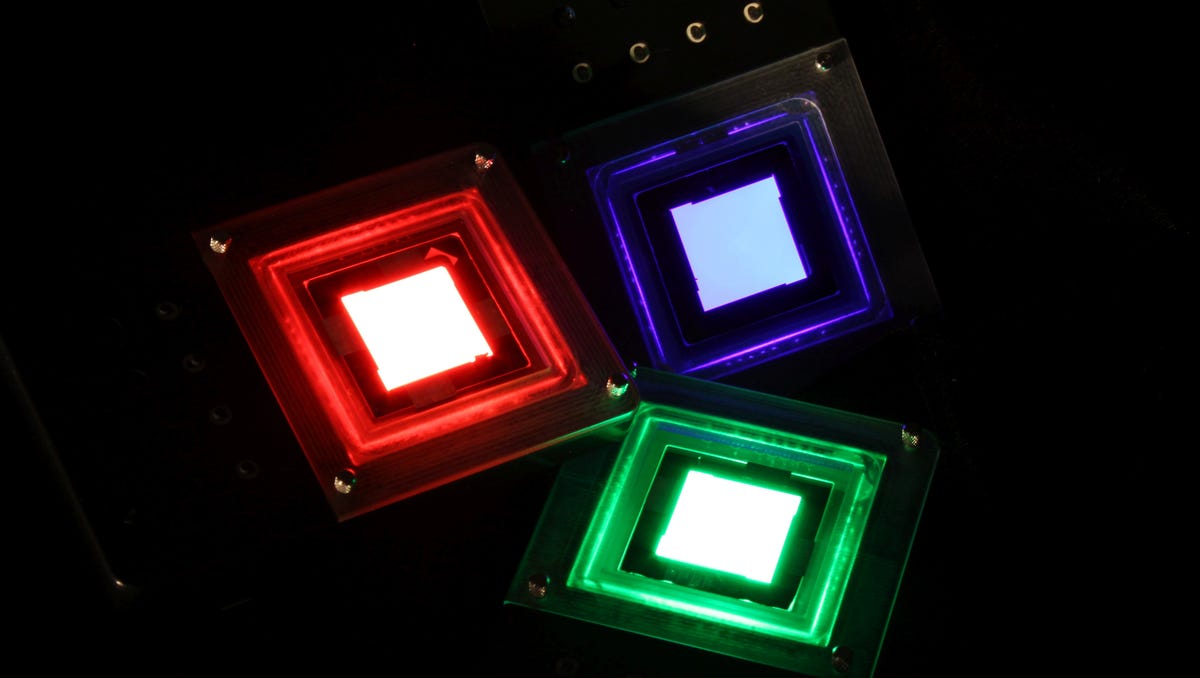
QDVision
Which is better in 2022 and beyond, QLED or OLED TVs?
As I mentioned above, when I pitted the best 2021 OLED against the best 2021 QLED, OLED still won — just like it has in previous years.
What about the future? Beyond its forthcoming QD-OLED TV, Samsung is researching direct-view quantum dot, which dispenses with the liquid crystal layers and uses quantum dots themselves as the light source. Emissive QLED TVs have the potential to match the absolute black levels and “infinite” contrast ratio of OLED, with better power efficiency, better color and more. That’s pretty exciting, but it’ll be a few years before we see emissive QLED TVs available for sale. Hopefully, by then they’ll think up a new acronym (EQLEDs?).
And then there’s MicroLED. It’s another emissive technology, once again spearheaded by Samsung but also sold by LG, that’s on sale now for the super rich — the largest examples cost more than $1 million. As you might guess from the name, it uses millions of teeny-tiny LEDs as pixels. MicroLED has the potential for the same perfect black levels as OLED, with no danger of burn-in. It can deliver higher brightness than any current display technology, wide-gamut color and doesn’t suffer the viewing angle and uniformity issues of LCD. It’s also friggin’ huge. It doesn’t involve quantum dots, at least not yet, but who knows what might happen when it comes to market. QDMLED, anyone?
For now, however, OLED rules the picture quality roost over QLED.
Best TV for 2022: OLED, QLED, LED and 4K for Every Size, Budget
Here are the best TVs to look for during upcoming Black Friday sales, from inexpensive LCD models to high-end screens.
We’ll notify you whenever the product drops 10% below the original price.
Black Friday and the 2022 holiday shopping season are coming up fast, and if you’re looking for a new TV, now is the time to save. TV prices are cyclical and every year the best TV deals start happening during the fall and into the winter as stores slash prices and TV-makers compete for your dollar. But which TVs are actually good? Our list, featuring TVs we’ve reviewed side by side, is designed to help you find the best TV for you, from high-end OLED and QLED models to budget LCD TVs and everything in between.
Now, on to our picks.
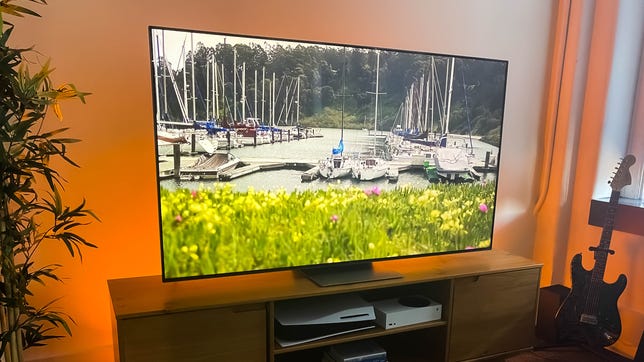
David Katzmaier/CNET
TCL 6-Series Roku TV
Best TV for the money
Sizes
55-, 65-, 75- 85-inch
TV Technology
QLED with Mini-LED
Smart TV
Yes (Roku TV)
Resolution
4K
HDMI Ports
4
For the last five years the TCL 6-Series has been our favorite TV for the money, and the 2022 version — also known as the R655 series — is no exception. This TV has an excellent image thanks to mini-LED tech and well-implemented full-array local dimming that helps it run circles around just about any other TV at this price. It improves upon the previous R635 series with improved gaming extras and a new center-mount stand that you can elevate to make room for a soundbar, although the new 85-inch size has standard legs. And finally, the Roku TV operating system is our hands-down favorite.
Note that in addition to the R635, which this TV replaces, other versions of the 6-Series were released in 2021 and remain on sale. The R646 series uses the Google TV operating system but otherwise has similar specifications to the R655 models reviewed here. The R648 series has 8K resolution and is significantly more expensive.
The prices shown below are for the 65-inch size.
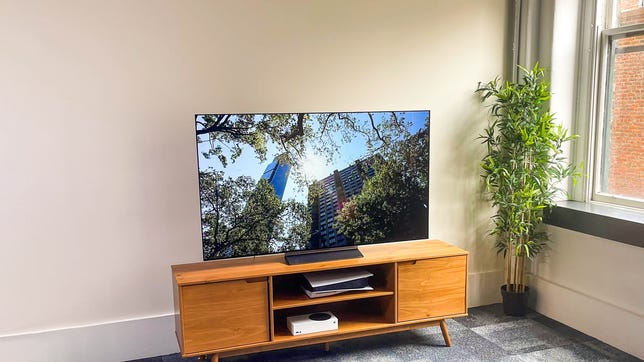
David Katzmaier/CNET
LG OLED C2
Best high-end TV for the money
The C2 represents the pinnacle of picture quality at a price that’s admittedly high, but not too crazy. It beats any non-OLED TV on this list, including the Samsung QN90B below, with its perfect black levels, unbeatable contrast and superb off-angle viewing. It also has superb gaming features, making it the perfect companion to an Xbox Series X or S, PlayStation 5 or both. The C2 comes in a variety of sizes as well, although the bigger models are expensive.
Improvements over the C1 from last year include carbon-fiber construction for up to 47% lighter weight — the 65-inch version we reviewed weighs just 37 pounds with its stand, compared to 72 pounds for the 65-inch C1 — as well as some additional tweaks to game mode and a new “always ready” feature.
The prices shown below are for the 65-inch size.
$1,649 at Walmart
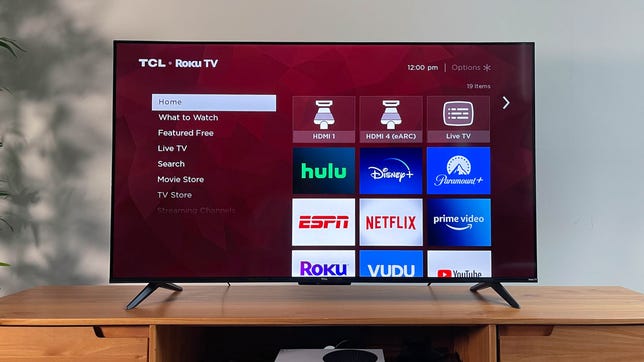
David Katzmaier
TCL 4-Series
Best budget smart TV for built-in streaming
Sizes
43-, 50-, 55-, 65-, 75-, 85-inch
TV Technology
LED
Smart TV
Yes (Roku TV)
Resolution
4K
HDMI Ports
3
The picture quality of the TCL 4-Series Roku TV was a step behind the Vizio V-Series in our budget TV test, but the differences between the two are slight enough that you’d really have to have them set up side by side to notice anything at all. The 4-Series lacks the Dolby Vision, Bluetooth connectivity and AMD FreeSync with a variable refresh rate, all of which the Vizio offers.
The 4-Series’ advantage over the Vizio is that it comes with the excellent Roku Smart TV system built in. That makes it a great choice for those looking for a one-stop smart TV solution, without having to add an external streaming device.
The prices shown below are for the 50-inch size.
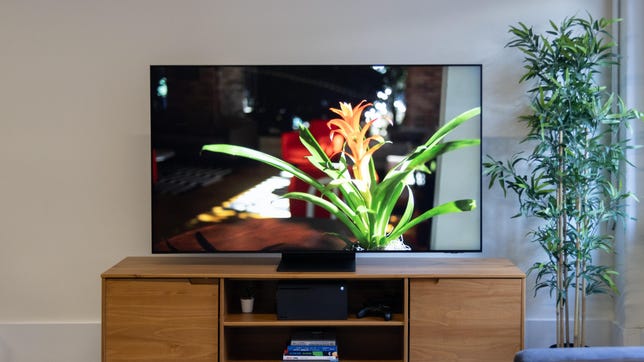
Bobby Oliver/CNET
Samsung QN90B
Best high-end TV that’s not an OLED
Sizes
43-, 50-, 55-, 65-, 75-, 85-inch
TV Technology
QLED with Mini-LED
Smart TV
Yes (Tizen)
Resolution
4K
HDMI Ports
4
Looking for a high-end TV with spectacular image quality, but don’t want an OLED? The Samsung QN90B is your best bet. This TV uses QLED TV tech augmented by mini-LED for a brighter image than any OLED TV. The spectacular contrast of OLED still won out in our side-by-side tests, but the QN90B QLED screen comes closer than ever.
The prices shown below are for the 65-inch size.
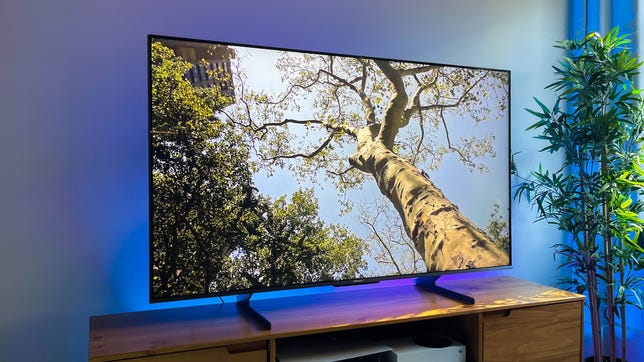
David Katzmaier/CNET
Hisense U8H
Best TV for the money runner-up
Among midpriced models we liked the TCL 6-Series just a little better in our side-by-side comparison, but this Hisense is a strong contender. Its excellent image quality is anchored by best-in-class brightness that improves its bright-room picture quality and makes HDR TV movies, shows and games really pop. It’s actually brighter than the TCL with better contrast, but the TCL’s slightly more accurate image gave it the edge overall. The Hisense uses Google TV instead of Roku, and unlike the TCL, the U8H includes an ATSC 3.0 tuner. Frankly, you can’t go wrong with either one.
The prices shown below are for the 65-inch size.
$998 at Walmart
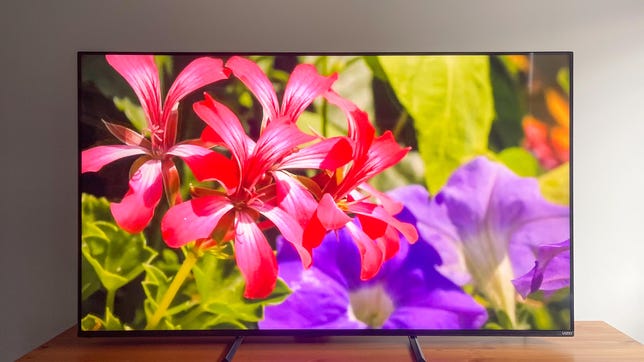
David Katzmaier/CNET
Vizio MQX
Best midpriced TV for tighter budgets
Sizes
50-, 65-, 75-inch
TV Technology
LED with local dimming
Smart TV
Yes (SmartCast)
Resolution
4K
HDMI Ports
4
The Vizio MQX is one of the least expensive TVs to feature full-array local dimming, which lets it reproduce TV shows, movies and games with enough contrast and pop to do HDR justice. The MQX has fewer dimming zones than more expensive TVs like the TCL 6-Series and Hisense U8H, but it offers 16 zones on the 50-inch, 30 on the 65-inch and 42 on the 75-inch, which is more than enough for excellent overall picture quality, with bright highlights, dark black levels, punchy contrast and accurate color.
Unlike the M7 last year, the MQX has a true 120Hz refresh rate, which allows compatibility with 4K/120Hz signals from game consoles like the Xbox Series X and PlayStation 5, and worked well in our tests. Vizio supports both major HDR formats, HDR10 and Dolby Vision, in the M-Series. If you can’t save up for the TCL or the Hisense but want a better picture than the TCL 4-Series or Vizio V-series, the Vizio MQX is an excellent happy medium.
The prices shown below are for the 65-inch size.
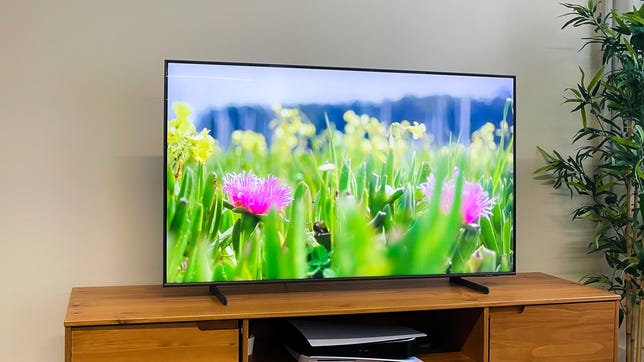
James Martin/CNET
Samsung Q60B
Best design in a midprice TV
Sizes
43-, 50-, 55-, 60-, 65-, 70-, 75-, 85-inch
TV Technology
QLED
Smart TV
Yes (Tizen)
Resolution
4K
HDMI Ports
3
Samsung is the brand that sells more TVs than anyone, and one of its most popular is the Q60 series. Its sleek QLED screen design stands out compared with the other TVs on this list — even though the ultrathin OLED models are sleeker — and it offers better features, image quality and more sizes than models like the TCL 4-Series and Sony X80K. The TVs listed in this article are all superior values, but if you want a Samsung TV and can’t afford the QN90A, this is a great choice.
The prices shown below are for the 55-inch size.
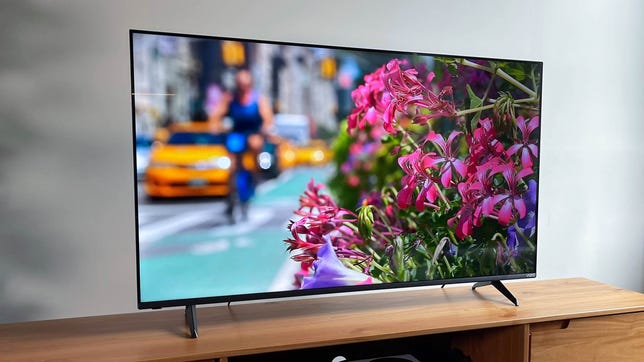
David Katzmaier
Vizio V-Series
Best budget TV for picture quality
When we compared the best 2022 budget TVs side-by-side, the picture quality of Vizio V-Series clearly emerged as the leader of the pack. The Vizio offered the most balanced and accurate picture during our comparisons, and it comes with some useful extras such as Dolby Vision support, Wi-Fi 6E, Bluetooth compatibility and variable refresh rate for potentially smoother gaming. The biggest downside of the Vizio is its smart TV platform, Vizio SmartCast. It’s crowded, slow and littered with ads for platforms such as Tubi and Kidoodle TV. Even when you factor in the cost of adding a new streaming device, however, the V-Series remains the best overall entry-level TV that we tested.
The prices shown below are for the 50-inch size.
Other TVs we’ve tested
Sony KD-X80K series: Sony is a prominent brand and its higher-end TVs like the X90J do well in reviews, but the entry-level TV in its 2022 lineup, the X80K, didn’t make the list. It costs around the same as the TCL 6-Series and Samsung Q60 TVs, and had a worse picture than both, with lighter black levels and contrast. It’s definitely not a bad TV, and we liked its Google smart TV system, color accuracy and connectivity, but you can definitely do better for the money. Read our Sony KD-X80K series review.
Toshiba Amazon Fire TV C350 series: One of many Fire TVs available for sale, this one is typical of the breed: so-so image quality and a smart TV system that lags behind Roku and Google TV. If you’re a big fan of Alexa voice or see this TV at a really low price it might be worthwhile, but otherwise go for the TCL 4-Series. Read our Toshiba Amazon Fire TV C350 series review.
LG OLED G1 series: The G1 is an excellent overall TV, but compared to the C1 and C2, we don’t think it’s worth the extra money. Image quality is basically the same as those two models, so you just end up paying extra for its ultrathin, wall-hugging “gallery” design. On the other hand if that price difference is small enough — sometimes a G1 will cost only $100 more than a C1, for example — it might be worthwhile for you. Note that this TV’s successor, the 2022 LG G2, promises a brighter picture, but we haven’t reviewed it yet so we can’t say for sure. Read our LG OLED G1 series review.
How does CNET test TVs?
Our TV reviews follow a rigorous, unbiased evaluation process honed over nearly two decades of TV reviews. Our primary TV test lab has specialized equipment for measuring light and color, including a Konica Minolta CS-2000 spectroradiometer, a Murideo Sig-G 4K HDR signal generator and an AVPro Connect 8×8 4K HDR distribution matrix. We use Portrait Displays CalMan Ultimate software to evaluate every TV we review. In every CNET TV review, three or more similar TVs are compared side by side in various lighting conditions playing different media, including movies, TV shows and games, across a variety of test categories, from color to video processing to gaming to HDR. Our reviews also account for design, features, smart TV performance, HDMI input and gaming compatibility and other factors.
TV FAQs
We’ll post the answers to commonly asked TV questions below. If you have any others, feel free to reach out on Twitter (@dkatzmaier), or by clicking the little envelope icon on my CNET profile page. Doing so will let you send a message straight to my inbox.
How much should I spend on a TV?
Prices vary widely by size and features, from less than $100 for basic 24-inch TVs to more than $2,000 for big OLED models. TVs last a long time, however, so we think it’s worthwhile to spend a little extra beyond the bare minimum to get a bigger screen, better picture quality or better features. With that in mind, here’s some ballpark prices that will get you a very good TV in 2022.
- 55-inch: $700
- 66-inch: $1,000
- 75-inch: $1,300
You could pay (much) more or less. The fact is just about any TV will produce a picture decent enough to satisfy most viewers. Most complaints you read in user reviews aren’t about picture quality. Instead they’re about ease of use, smart TV menus or sound (or a broken TV).
What size TV should I buy?
In our opinion bigger is better, and your money is best spent on large screen sizes rather than a slight upgrade in image quality. The answer also depends on room size and seating distance: If you have a big room and sit farther away, you’ll want a bigger TV.
Which is better, OLED or LED?
In our reviews, OLED TVs, which use organic light-emitting diode technology, have always had better picture quality than LED TVs, which are basically LCD TVs that use LED backlights. The main reason is that OLED TVs can produce a perfectly dark shade of black with no stray illumination of blooming, which leads to better contrast and pop. LED TVs can get brighter, however, and usually cost less than OLED TVs.
What is the best smart TV system for streaming?
At CNET our favorite is Roku for its simplicity, but different systems like Google TV, Amazon Fire TV, Samsung and LG have different strengths, in particular for voice commands. In any case, we don’t consider the built-in smart TV system that important because you can always connect a streaming device to any TV.
How do I get the best TV sound?
Most TVs sound terrible, because their thin cabinets don’t have room for decent-size speakers or bass. If you want to get good sound you should buy an external audio system. Even an inexpensive soundbar will deliver much better audio quality than a TV’s built-in speakers.


